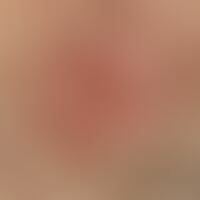Image diagnoses for "Nodules (<1cm)"
393 results with 1370 images
Results forNodules (<1cm)

Scabies nodosa B86.x

Folliculitis (superficial folliculitis) L01.0
Folliculitis (superficial folliculitis): 0.5 cm large, inflammatory, non-purulent follicular papules.

Arsenic keratoses L85.8

Skabies B86
Scabies (overview): itchy "rash" all over the body, existing for weeks; see previous figure. findings: disseminated, red scaly papules, partly also linearly arranged. itching at night intensified in bed warmth

Neurofibromatosis (overview) Q85.0
type i neurofibromatosis, peripheral type or classic cutaneous form. numerous smaller and larger soft, predominantly pigmented, practical nodules and nodules. in the larger nodules the so-called "bell-button phenomenon" can be detected. the palpating finger penetrates the deep dermis as if through a fascial gap. few café-au-lait spots. papules and nodules. only isolated rather discreet café-au-lait spots.

Epidermal cyst L72.0
Epidermal cysts. 48-year-old female patient, skin change since 1 year, progressive. findings: Multiple, disseminated, localized on forehead and cheeks, skin-colored, rough, noncolored papules with smooth surface, about 0.3 x 0.8 cm in size.

Pyogenic granuloma L98.0
Granuloma pyogenicum (pyogenic granuloma) Rapidly growing, shiny tumour on the palm of the hand. Previous harmless stab wound. The inlet shows a collar-shaped enclosure of the granuloma by the surrounding skin.

Sweet syndrome L98.2
Dermatosis, acute febrile neutrophilic. reddish-livid, succulent, pressure-dolent, infiltrated, solitary and partly confluent papules confluent to plaques, on the right side of the body in a 33-year-old patient. 1 week before the onset of the disease a fever attack with temperatures > 38 °C occurred.

Pediculosis capitis B85.0
Pediculosis capitis: Numerous nits, recognizable as white spots on the hair shaft, in a 7-year-old girl. Several schoolmates are also affected. Painful lymphadenitis in the occipital region due to scratching effects with subsequent eczematization (lice eczema; not visible here) and impetiginization.

Keloid acne L73.0

Dyskeratosis follicularis Q82.8
Chronicdyskeratosis follicularis, also affecting the Rima ani (see detailed picture), intertriginous, whitish and red-brownish sooty, blurred, macerated, superficially rough, clearly increased in consistency, itchy and unpleasantly smelling plaques.

Giant cell arteritis M31.6
Arteriitis temporalis. string-like thickened, focal indurated and painful arteria temporalis. at the same time strong, right-sided, temporal headache. no visual disturbances.

Syphilide papular A51.3
Syphilide, papular. multiple, acute, still increasing, generalized (trunk, extremities, palms of hands, soles of feet affected), predominantly isolated, 0.1-0.3 cm large, confluent in places (chest region), red or reddish-brownish, rough, slightly scaly spots. fatigue, generalized, non-painful lymphadenopathy, positive serology.

Erythema multiforme, minus-type L51.0
Erythema multiforme. 10-year-old female patient with Z.n. herpes simplex virus infection 4 weeks ago. multiple, acutely occurring, itching, clearly infiltrated, 0.2-0.7 cm large, sharply defined, firm, red, smooth papules and partly confluent plaques with partly cocardial aspect and central blistering.

Xanthome eruptive E78.2
Xanthomas, eruptive:0.1-0.3 cm large, yellow-brown, flat raised, superficially smooth and shiny, firm papules in dense seeding in a 54-year-old patient with known hyperlipoproteinaemia type IV.

Erythema perstans faciei L53.83
erythema perstans faciei. persistent, asymptomatic, symmetrically arranged reddening of the face, which increases with excitement and stress. follicular hyperkeratosis clearly visible with enlargement.

Familial atypical multiple birthmark and melanoma syndrome (FAMM) D48.5
BK-Mole syndrome: multiple irregularly configured and stained melanoytic nevi. condition after surgery of a malignant melanoma (shoulder left).

Drug reaction lymphocytic T88.7
drug reaction, lymphocytes: multiple, non-symptomatic, surface-smooth papules and plaques. occurred several months after cardiological readjustment. patient otherwise healthy. no evidence of lymphatic systemic disease. no other drugs. histological: nodular, mature lymphocytic tissue. no lymph follicles.






